Wilshire United Methodist Church
Allison & Allison – 1925
4350 Wilshire Boulevard – map
Declared: 3/7/73
When it was announced in January 1923 that the Wilshire Congregational Church would get a home of its own at the corner of Wilshire and Plymouth, Carleton Monroe Winslow, whose most current project was the city’s new Central Library, was the architect. Plans called for a $500,000, Spanish/Colonial complex of three units around a central patio with the church’s main entrance facing Plymouth. However, Winslow’s plans were scrapped, and the team of Allison & Allison was brought in. (Don’t feel to bad for Winslow. He also worked on St Paul’s Episcopal Cathedral (HCM No. 66) and went on to design St Mary of the Angels Church (HCM No. 136).)
James and David Allison’s works are all over the list of the city’s Historic-Cultural Monuments, including the 13th Church of Christ, Scientist (No. 559), the Irving Branch Library (No. 307), and the Southern California Edison Building (No. 347). They’re also famous for a bunch of buildings at UCLA, the Beverly Hills Post Office, and high schools in Burbank, Palo Alto, and Santa Monica.
The Allisons used several styles on the steel and concrete church, but mostly Romanesque on the outside and Gothic on the inside. For the façade and 140-foot tower, the team was inspired by Brescia’s Church of St Francis in Italy and the La Giralda in Sevilla, Spain.
A shot of the inside.
Born in Cornwall, England, in 1875, emigrating to the U.S. in 1892, Dr Frank Dyer founded the Wilshire Congregational Church in 1921, the year he moved to Los Angeles from Tacoma, WA. From the get-go, he decreed his church would strive to be non-sectarian, a stance that would continue to rankle the Congregational Church fathers.
Construction began at the end of October 1924 with McDonald & Driver winning the spot of general contractors. When the church opened on May 24th the next year, the congregation of 550 members had room to spare in the auditorium built for 1,400. By this time, Dyer had brought in a co-pastor to share his load, Kansas City clergyman Dr Charles Frederick Aked.
Officials broke ground early October in 1926 for two new units – Gunsaulus Hall, named for Dr Frank W. Gunsaulus, a Chicago minister who had died about five years earlier, and a church school/gymnasium.
The Reverend Dyer was controversial to say the least, unpopular with church elders and co-workers alike. In 1925, Dr Aked left the congregation, later calling Dyer an “ingrained liar, a man of savage passion, ruthless selfishness and acting in bad faith.” Dyer’s subsequent co-pastor, Dr Thomas B. Harper, also split on bad terms with Dyer.
Now, if charges such as playing jazz in the church and, worse, supporting the ACLU, weren’t enough for the Congregational Church to take action, the feces hit the fan when, in the spring of 1928, in order to raise $50,000 to stave off foreclosure, Dyer announced Jack Dempsey would take part in a charity bout. In just a few weeks, nearly all of the 110 pastors and delegates of the Los Angeles Congregational Association voted to find Dyer guilty of “conduct unbecoming a minister, misrepresentation of facts and responsibility for bringing disgrace on the denomination by sanctioning a boxing bout to raise money for church indebtedness.” Dyer vowed to continue to fight for his preaching gig and the church he founded seven years earlier, even after being ousted with Dr Thomas Harper being called back for pastor duties.
From LAPL.org, a shot of whom I'd bet dollars to donuts is Dr Dyer.
Dyer’s battle was a futile one, though. In May 1929, 150 members of the All Souls’ Church voted to take over the Wilshire and Plymouth church in a sale involving more than $300,000. Up until that time, All Souls’ Church had no buildings, holding its services in theaters. Oh. All Souls’ minister was Dyer’s old co-pastor, Dr Aked.
Dr Frank Dyer went on to preach and write in the Los Angeles area until his death in 1963 at the age of 88.
Widening Wilshire in the late 1920s, also from LAPL.org.
All Souls’ tenure in the church building was short-lived, too. Aked announced his resignation at the end of 1930 when the buildings were put up for sale. In the fall of 1934, the Wilshire Methodist Episcopal Church moved in, leaving its home at Hobart Boulevard and Second Street. (The Wilshire Methodist Episcopal Church was founded in 1907 as the Hobart Methodist Church. In 1927, it merged with the Westlake Methodist Church, itself having merged with the Simpson Methodist Episcopal Church in 1910. A final merger in 1973 with Trinity Methodist Church created the newly-named Wilshire United Methodist Church. I think some sort of family tree is needed here.)
A monument to the church's history.
Today, Wilshire United Methodist Church is made up of four ministries: Korean, Filipino, English, and Hispanic, with the first two autonomous.
According to the Church’s website, there used to be a parsonage on Lucerne Boulevard and a parish house that were torn down to make way for Ritter Chapel (named for Fred Ritter), the Children’s Educational Chapel (1951), and a parking lot addition.
The Children's Educational Chapel (1951).
And, now, the important stuff.
Actress Ethel Shannon married screenwriter Joseph Jackson here on April 10, 1927. Dyer presided.
Reginald Denny was best man when Laura La Plante married William Seiter here.
Jeanette MacDonald and Gene Raymond got hitched here on June 16, 1937. Nelson Eddy sang, Basil Rathbone and Harold Lloyd were ushers, and Fay Wray and Ginger Rogers were maids of honor. (Thanks for the information.)
In September of 1945, John Agar hit the jackpot when he married Shirley Temple at the church. She was seventeen.
Sources:
To Open Church in Hotel. Los Angeles Times; 12/31/21
Church Plans Are Indorsed [sic] Los Angeles Times; 1/28/23
Will Launch Church Drive Los Angeles Times; 3/18/23
Church Edifice is Commenced Los Angeles Times; 11/2/24
Wilshire Church to Open Los Angeles Times; 5/23/25
New Units of Church Under Way Los Angeles Times; 10/4/2
Church Issues Plea for Help Los Angeles Times; 4/30/28
Dr. Dyer Will Face Charges Los Angeles Times; 5/27/28
Ministers Vote Dr. Dyer Guilty Los Angeles Times; 6/8/28
Dr. Dyer Will Keep Up Fight Los Angeles Times; 6/13/28
Church to be Taken Over Los Angeles Times; 5/23/29
Costly Church for Sale Los Angeles Times; 12/30/30
Buildings Acquired by Church Los Angeles Times; 9/30/34
Dr. Frank Dyer, Veteran L.A. Churchman, Dies Los Angeles Times; 9/14/63
Actress Ready for Her Nuptials Los Angeles Times; 11/11/26
Up next: Evans Residence

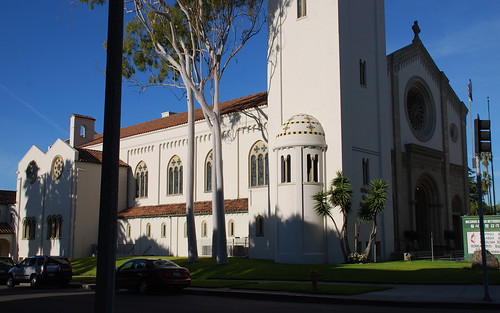
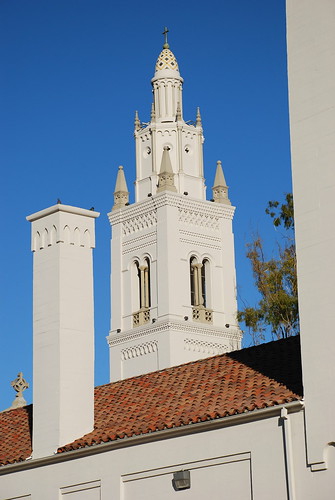
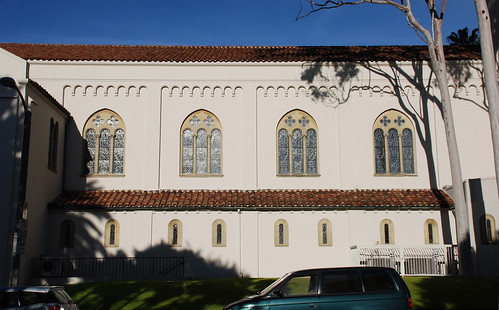
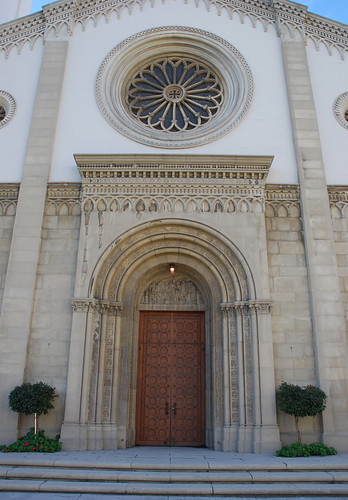
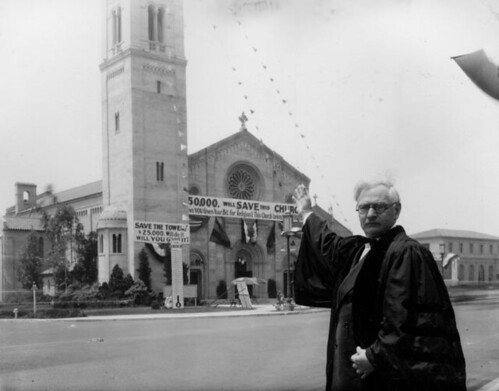
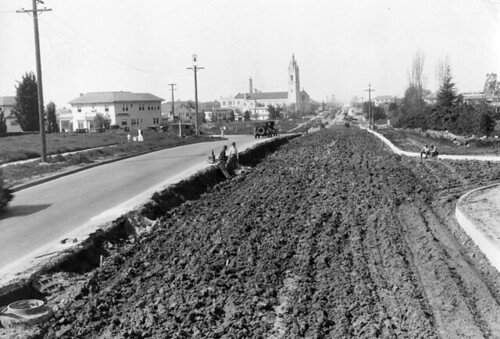
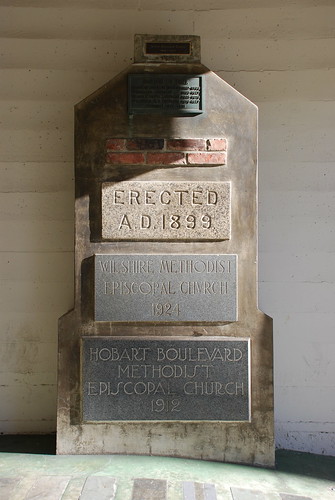
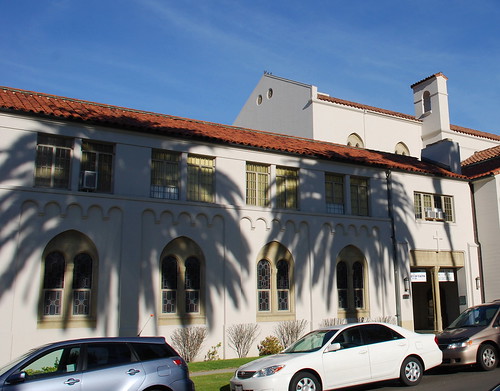
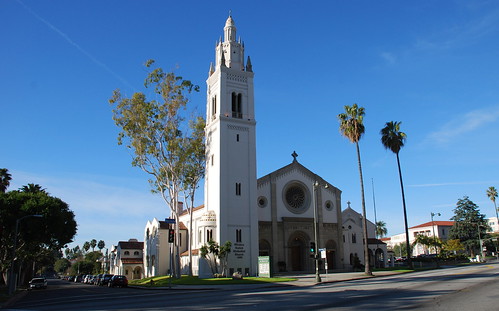
The photo is of Rev. Frank Dyer, who was my great Uncle. John Charles Dyer. He was, as were all of his 20 or so brothers and sisters, a devotee of duty, but I remember him for making little rafts of popsicle sticks with leaf sails to set afloat on the creek bed near his Santa Monica home. He had a humungous voice, which he no doubt mimicked from his father, my great grandfather, who was a noted folk singer in Cornwall in his day (as was Frank's brother Joe who sang back up in those days for Hollywood stars). His sons went on to great success. His eldest, Braven, was head sportswriter for the LA Times. Bonar was Disney's HR Director and trouble shooter. Brainard was a noted UCLA professor. Frank Jr. was a Wilshire Blvd. stockbroker. The family is still around and contributes to society in general. There are always two stories and I think this one was a story of cultural conflict. Folks do not realize how different was the culture of UK from that of the USA.
ReplyDeleteHi, John. Thanks very much for all the information. You may be right regarding the cultural conflict. It sounds like a John Ford movie.
ReplyDeleteGod bless you. We are looking forward your faith church ... Please pray for us. We opened the first Methodist church in Transylvania, Romania.
ReplyDeleteDinu and Gabriela
www.metodista.ro
pastor@metodista.ro
I think for us looking back on it, the culture clash was less Britain vs. America, more secular vs. sectarian. All the conflicts mentioned about Frank Dyer potentially included race, Blacks, etc. Jazz, and later Rock and Roll, where considered the Devil`s music, and black music, and dance music, all of which were considered evil by some. The Aclu chrusade for civil rights, including for black people. Jack Dempsey was a white boxing champ, but soon blacks took over the sport. In Downey, Cal., Frank`s Gospel bass singer, and Methodist, half brother`s nephew, Will Dyer, was turned down for a church which had hired him, perhaps because the may have thought he ministered to blacks, maybe even thought he married a black, when he was a missionary to the Bahamas (she came from a segregated all white town). Coffee and tea and soft drinks were banned by religion because of the caffeine. Women were not allowed to wear light make up, it was said to be misbehaving like a prostitute. So by their standards, Rev. Dr. Dyer had gone Hollywood. He was also accused of crime, but that was disproven in court. Anyone can be accused, not everyone is guilty.
ReplyDeleteJust a minor technical point, my father, William Dyer, was the son of Albert Dyer, Frank's brother, not half brother. It is a minor point but important in the family.
ReplyDeleteYes, my mother was a white Bahamian. That too was a controversy as the English Methodist church did not allow its missionaries to marry locals. Mother and Dad broke a barrier together with the support of the other ministers and Methodist laity (not to mention Pr. Edward). They were indeed missionaries to large congregations in Nevis and St. Kitts, and would have gone to Malaria but for mom;s malaria. Dad was notified that he had been "fired" from the local Orange congregation by telegram in the Miami airport while he and mom were uprooted on the way. The Bishop of the Calif Nevada conference, also Cornish, heard of it and arranged an appointment in Indiana within the day.
Great Uncle Frank was a warm man although his booming voice could be a bit frightening. He was really very typical of his brothers, all raised on DUEtea. Interestingly, something like 11 of his 13 brothers entered career military service, including my grandfather.
The issue alluded to in the first paragraph is Frank and Albert's father, Charles, married twice and had a total of 21 children. Interestingly how life moves in circles. I became friends with a woman in the UK whose favorite story was Martin Dyer's piece for the Daphne Du Maurier family on Mennabilly. Neither of us realized the connection until we commented on each other's photographs in FlickR.
Yes, Albert Dyer was a full brother of Dr. Frank Dyer, as was John Braven Dyer, whom he named his first son after. Dr. Frank worshipped in both the local Jewish Synogogue in the Chicago area, and his own Congregational Church when he studied to be a minister, having been raised Methodist. Josiah Dyer, the deep bass singer, was one of Frank`s half brother`s. And William Dyer, his nephew, boxed in the five highest weight classes in the British Navy, Middle, Welter, Light Heavy, Cruiser, Heavy, though by weight he belonged in the smallest.
ReplyDeleteAnd the Northern California Bishop, Tippet, had worked in Southern Cal before moving north, and lost an eye to the Legs Diamond mob.
ReplyDeleteGood. Looks like we are talking about the same family.
ReplyDeleteAnyway, as other readers can see, the colourful nature of the family came with Frank and did not end with him. Will's son John (Charles)
Braven Dyer was born May 29, 1900, the 1901
ReplyDeletedate from the California Death Records is in error, his brother Brainerd was born five months after that, on Nov. 9, `01.
On September 12, 1918, Braven filled out his WWI Civilian Draft Registration
card as May 29, 1900 date of birth.
He was a student at Stadium High School and lived on 1421 Division Avenue in
Tacoma, WA. He filled in blue eyes, brown hair.
He also filled out a passport application on June 13, 1923 for Washington
State.
He claimed his date of birth as May 29, 1900 in Chicago, IL. He said his
father, Frank, was born in England.
He claimed to be a student living in Los Angeles.
Strangely, he also listed his eyes as brown, his hair as black and his height
as 5'5.5. He has also been listed as 5`10.
In September, 1923, he also listed his date of birth the same on a ship's
manifest (Laconia).
There are other luxury liners that list his date of birth as May 29, 1900.
@Anonymous. Look me up at Heritage Sites under Dyer. I have a fair amount of detail and not some other details. We are probable moving beyond the purpose of this site.
ReplyDelete